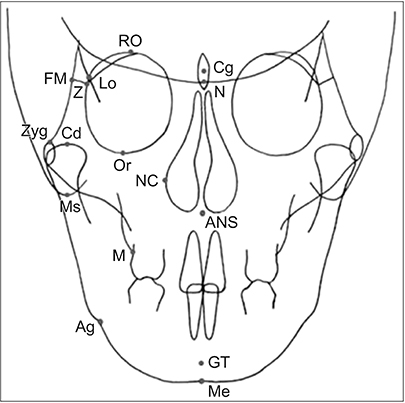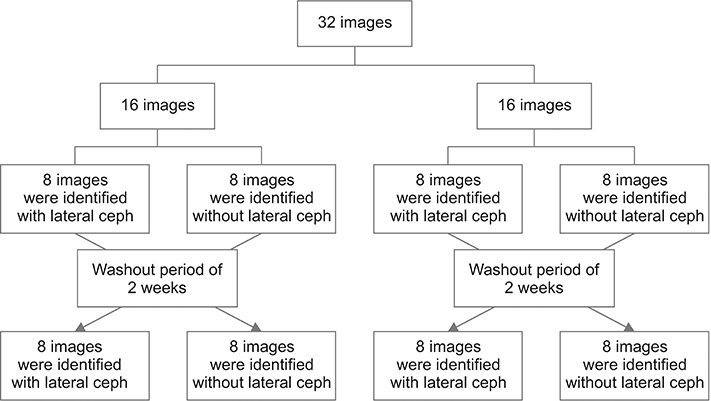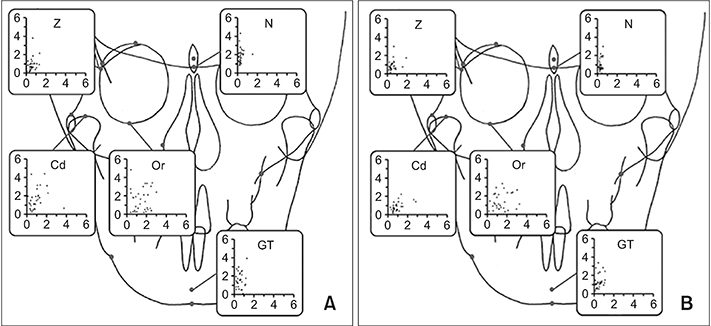Korean J Orthod.
2019 Jan;49(1):32-40. 10.4041/kjod.2019.49.1.32.
Benefits of lateral cephalogram during landmark identification on posteroanterior cephalograms
- Affiliations
-
- 1Department of Orthodontics, School of Dentistry, Chonnam National University, Gwangju, Korea. ortholkm@chonnam.ac.kr
- 2Department of Oral Radiology, School of Dentistry, Chonnam National University, Gwangju, Korea.
- KMID: 2431078
- DOI: http://doi.org/10.4041/kjod.2019.49.1.32
Abstract
OBJECTIVE
Precise identification of landmarks on posteroanterior (PA) cephalograms is necessary when evaluating lateral problems such as facial asymmetry. The aim of the present study was to investigate whether the use of lateral (LA) cephalograms can reduce errors in landmark identification on PA cephalograms.
METHODS
Five examiners identified 16 landmarks (Cg, N, ANS, GT, Me, RO, Lo, FM, Z, Or, Zyg, Cd, NC, Ms, M, and Ag) on 32 PA cephalograms with and without LA cephalograms at the same time. The positions of the landmarks were recorded and saved in the horizontal and vertical direction. The mean errors and standard deviation of landmarks location according to the use of LA cephalograms were compared for each landmark.
RESULTS
Relatively small errors were found for ANS, Me, Ms, and Ag, while relatively large errors were found for N, GT, Z, Or, and Cd. No significant difference was found between the horizontal and vertical errors for Z and Or, while large vertical errors were found for N, GT, and Cd. The value of identification error was lower when the landmarks were identified using LA cephalograms. Statistically significant error reductions were found at N and Cd with LA cephalograms, especially in the vertical direction.
CONCLUSIONS
The use of LA cephalograms during identification of landmarks on PA cephalograms could help reduce identification errors.
MeSH Terms
Figure
Reference
-
1. Broadbent BH. A new X-ray technique and its appication to orthodontics. Angle Orthod. 1931; 1:45–66.2. Letzer GM, Kronman JH. A posteroanterior cephalometric evaluation of craniofacial asymmetry. Angle Orthod. 1967; 37:205–211.3. Ricketts RM, Bench RW, Hilgers JJ, Schulhof R. An overview of computerized cephalometrics. Am J Orthod. 1972; 61:1–28.
Article4. Grummons DC, Kappeyne van de Coppello MA. A frontal asymmetry analysis. J Clin Orthod. 1987; 21:448–465.5. Hwang S, Noh Y, Choi YJ, Chung C, Lee HS, Kim KH. Dentofacial transverse development in Koreans according to skeletal maturation: A cross-sectional study. Korean J Orthod. 2018; 48:39–47.
Article6. El-Mangoury NH, Shaheen SI, Mostafa YA. Landmark identification in computerized posteroanterior cephalometrics. Am J Orthod Dentofacial Orthop. 1987; 91:57–61.
Article7. Major PW, Johnson DE, Hesse KL, Glover KE. Landmark identification error in posterior anterior cephalometrics. Angle Orthod. 1994; 64:447–454.8. Athanasiou AE, Miethke R, Van Der Meij AJ. Random errors in localization of landmarks in posteroanterior cephalograms. Br J Orthod. 1999; 26:273–284.
Article9. Legrell PE, Nyquist H, Isberg A. Validity of identification of gonion and antegonion in frontal cephalograms. Angle Orthod. 2000; 70:157–164.10. Brown T, Abbott AH. Computer-assisted location of reference points in three dimensions for radiographic cephalometry. Am J Orthod Dentofacial Orthop. 1989; 95:490–498.
Article11. Trocmé MC, Sather AH, An KN. A biplanar cephalometric stereoradiography technique. Am J Orthod Dentofacial Orthop. 1990; 98:168–175.
Article12. Bookstein FL, Grayson B, Cutting CB, Kim HC, McCarthy JG. Landmarks in three dimensions: reconstruction from cephalograms versus direct observation. Am J Orthod Dentofacial Orthop. 1991; 100:133–140.
Article13. Kim EH, Hwang HS. The validity of head posture aligner in posteroanterior cephaiometry. Korean J Orthod. 2000; 30:543–552.14. Leonardi RM, Giordano D, Maiorana F, Greco M. Accuracy of cephalometric landmarks on monitor-displayed radiographs with and without image emboss enhancement. Eur J Orthod. 2010; 32:242–247.
Article15. Battagel JM. A comparative assessment of cephalometric errors. Eur J Orthod. 1993; 15:305–314.
Article16. Peck H, Peck S. A concept of facial esthetics. Angle Orthod. 1970; 40:284–318.17. Gugino CF. An orthodontic philosophy. Denver: Rocky Mountain, Inc.;1977. p. 1–2.18. Sassouni V. Orthodontics in dental practice. St. Louis: Mosby;1971. p. 330–337.19. Sassouni V. The face in five dimensions. Philadelphia: Growth Center Publications;1960. p. 2–34.20. Ricketts RM. Provocations and perceptions in craniofacial orthopedics. Denver: Rocky Mountain, Inc.;1989. p. 797–803.21. Eun CS, Hwang HS. Posteroanterior cephalometric study of frontal ramal inclination in chin-deviated individuals. Korean J Orthod. 2006; 36:380–387.22. Hwang HS, Hwang CH, Lee KH, Kang BC. Maxillofacial 3-dimensional image analysis for the diagnosis of facial asymmetry. Am J Orthod Dentofacial Orthop. 2006; 130:779–785.
Article23. Hwang HS. A new classification of facial asymmetry. In : McNamara JA, editor. Craniofacial growth series. Ann Arbor: The University of Michigan;2007. p. 269–294.
- Full Text Links
- Actions
-
Cited
- CITED
-
- Close
- Share
- Similar articles
-
- A comparative study of the reproducibility of landmark identification on posteroanterior and anteroposterior cephalograms generated from cone-beam computed tomography scans
- The use of posteroanterior cephalogram in orthodontics
- The validity of head posture aligner in posteroanterior cephaiometry
- The reliability of the cephalogram generated from cone-beam CT
- The comparison of landmark identification errors and reproducibility between conventional lateral cephalometric radiography and digital lateral cephalometric radiography





